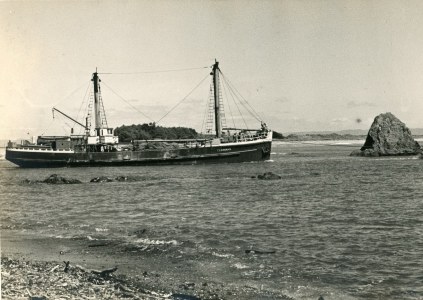The Ultimate New Zealand Soccer Website | home
Acoriano | Adi Viti | Aidan | Alexander | Ana Isabel | Anatoki | Apanui | Aranui | Arapawa | Arktis Pearl | Arktis Sun | Auckland Exporter | Auckland Express | Aupouri | Avon | Avondale | Awanui | Babinda | Baltimar Mars | Bay Fisher | Braveheart | Calm | Canterbury Express | Capitaine Cook | Capitaine Tasman | Capitaine Wallis | Capricornia | Carmen | CEC Pride | Clansman | Coromel | Cotswold Prince | Daniella | Fairlift | Fetu Moana | Fijian | Fijian Swift | Fijian Trader | Florida | Forum Micronesia | Frysna
Clansman
 Sourced from New Zealand Maritime Museum (1994.71)
|
||||||||||||||||||||
Built by G.T. Niccol of wood in Auckland for the Northern Steamship Company, she was initially known as "Waka" before being renamed "Clansman" on 1 October, 1934, initially for trading between Auckland all ports north.
It wasn't long before she was working her way around west coast ports, however, although one particular visit to Onehunga proved expensive when she suffered machinery damage off the Manukau Heads on 31 May 1939.
She made numerous calls to Onehunga during the 1940s, making her last call in June 1948, eight years before she ran aground inside the Whakatane bar. Such was the damage she suffered that upon arrival in Auckland, having been towed there for slipping, the repair work required proved to be uneconomical.
Thus all machinery and equipment was removed from "Clansman" and after lying derelict at St Mary's Bay for several year, she was broken up in Auckland in 1963, her remains being burnt at Greenhithe.
Legend has it that whenever "Clansman" arrived at Kawakawa in thick fog, her Master would sound long blasts on the ship's fog horn to attract the attention of the local townsfolk, who would respond by pounding away on empty kerosine tins to help guide the ship to the wharf!
|